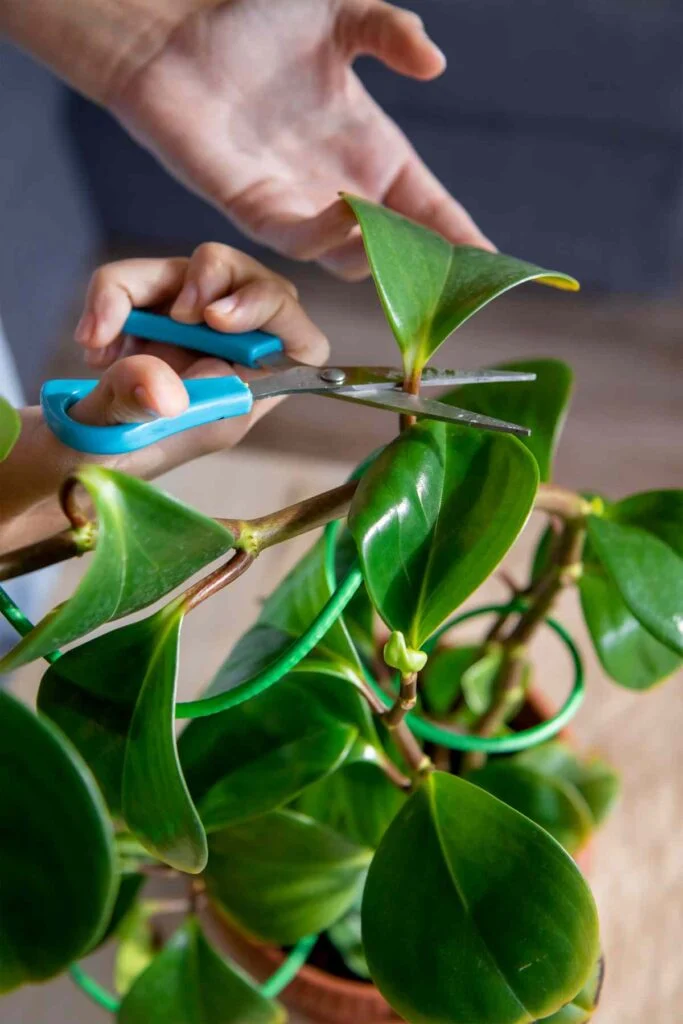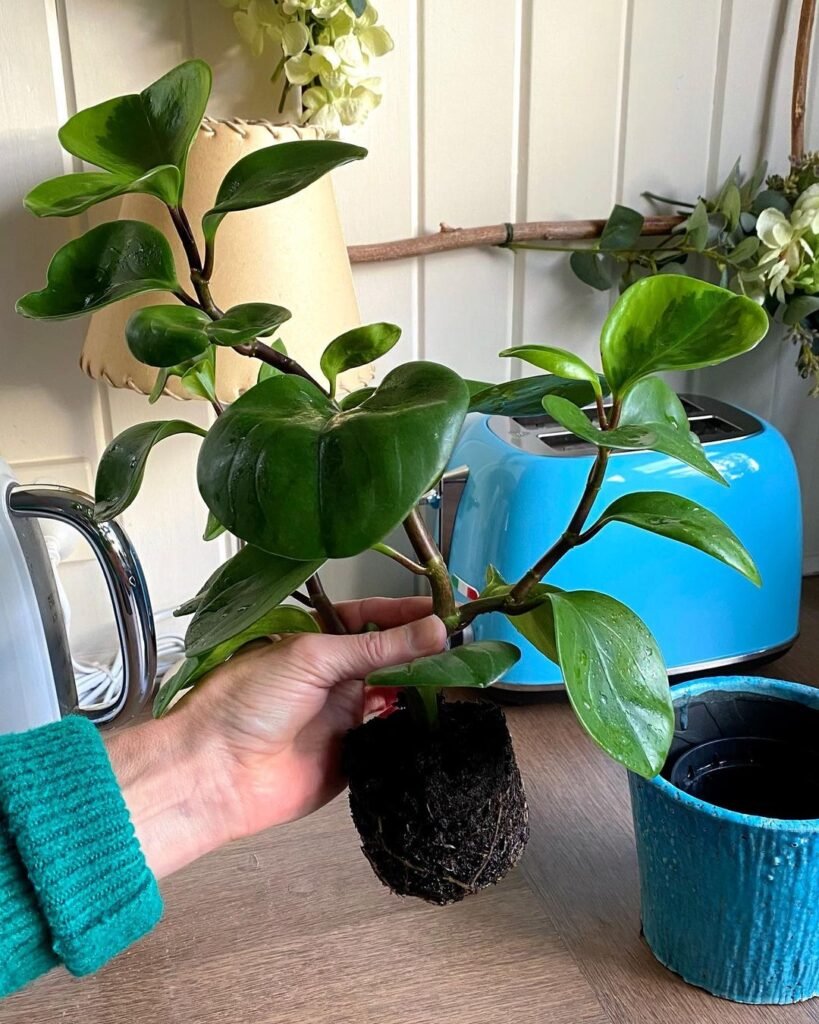Learn how to grow and care for the unique peperomia obtusifolia (baby rubber plant) indoors with this comprehensive guide to light, water, soil and more.
Looking for an attractive, low-maintenance houseplant to add to your indoor garden? The peperomia obtusifolia, also known as the baby rubber plant or American rubber plant, might be just what you need! These little plants are perfect for adding some green texture and interest to your home or office.
With their thick, succulent-like leaves andTraIling growth habit, peperomia obtusifolia plants have an almost alien look that is just plain cool. While not demanding at all, they do have some specific care requirements to keep them looking their best.
In this guide, we’ll cover everything you need to know to successfully grow and care for baby rubber plants indoors. Let’s dig in!
What is a Peperomia Obtusifolia?

The peperomia obtusifolia is a tropical perennial plant that originates from the forests of Mexico, the Caribbean and Florida. It is part of the Peperomia genus, which contains over 1,000 different species of small, fleshy-leaved plants.
While considered non-flowering plants, baby rubber plants do produce tiny greenish-white flower spikes in the right conditions. However, most people grow them for their distinctive foliage rather than their blooms.
Baby rubber plant leaves are thick, waxy and fleshy with a rubbery texture (hence the name). The leaves range in color from bright to deep green and take on a red or maroon tint when exposed to lots of sunlight. They grow in opposite patterns along fleshy, trailing stems that can reach 12 inches or more in length.
One of the best things about these plants is how easy they are to care for when you meet their basic needs. Baby rubber plants make wonderful low-light houseplants and are non-toxic to both humans and pets.
Types of Peperomia Obtusifolia
There are a few different cultivars and varieties of P. obtusifolia sold in garden stores and nurseries:
- Peperomia obtusifolia (Standard): This is the classic baby rubber plant with bright to deep green leaves.
- Peperomia obtusifolia ‘Albo-Marginata’: This variety has leaves edged in creamy white variegation.
- Peperomia obtusifolia ‘Variegata’: Featuring leaves splashed with golden yellow and pale green variegation.
- Peperomia obtusifolia ‘Mammoth’: As the name implies, this cultivar has much larger leaves up to 4 inches long.
- Peperomia obtusifolia ‘Minima’: A miniature form with very small 1/2 inch leaves and compact growth.
No matter which variety you choose, these plants all have the same basic care requirements and growing habits. The variegated types just add some extra visual interest to their patterned foliage.
Selecting a Healthy Plant

When purchasing a peperomia obtusifolia, look for plants that have full, bushy growth with plump, fleshy leaves. Avoid specimens with thin, wrinkled or dried leaves as this indicates poor care or pest issues.
It’s normal for the lower leaves to yellow and drop off older plants over time. But you want to make sure at least the top two-thirds of the plant is filled out nicely.
Check carefully for any pests like mites, mealybugs, scale or fungus gnats. Isolate any infested plants until you can treat them to avoid spreading issues to other houseplants.
Starting off with a robust, healthy plant sets you up for much better success in the long run!
Soil Needs for Baby Rubber Plants

One of the keys to growing a thriving peperomia obtusifolia is using the right type of well-draining soil. Like most succulents and cacti, they prefer a gritty, porous potting mix.
You can either purchase a commercially available succulent/cactus soil, or make your own mix by combining:
- 2 parts regular potting soil
- 1 part perlite or pumice
- 1 part coarse sand or fine bark
The extra drainage material prevents soggy soil and root rot, while also providing needed airflow around the roots. Drainage is critical, as peperomias are very susceptible to rotting if kept in wet, dense soil.
When potting or repotting, use a container with multiple drainage holes in the bottom. Terra cotta and unglazed ceramic are ideal as they are breathable and allow excess moisture to evaporate through the sides.
The potting mix should feel light and airy and never become completely saturated. Water will drain through it very quickly.
Providing the Right Light

In their native Mexican and Caribbean environment, peperomia obtusifolia grow as understory plants in bright, dappled shade under the forest canopy.
Replicating this light exposure is key for keeping these plants happy indoors. They need bright, indirect light but will scorch in direct sunlight.
An east or north-facing window is perfect, as it provides plenty of bright natural light without intense sun rays. You can also position them a few feet back from a west or south-facing window with sheer curtains to diffuse the light.
Signs your baby rubber plant is getting too much light:
- Leaves turn reddish in color
- Leaves become pale or washed out
- Leaves develop burn spots or holes
- Leaves fall off excessively
On the flip side, signs of too little light include:
- Long, stretched out stems as it reaches for light
- Leaves lose their variegation pattern
- Leaves look dull and lose their sheen
- Plant stops producing new growth
Achieve a happy medium of bright, indirect light and your peperomia obtusifolia will thrive and maintain its vibrant leaf coloring.
Proper Watering for Baby Rubber Plants

Like their succulent cousins, peperomias are very prone to root rot when overwatered. But they also can’t tolerate completely drying out between waterings.
The key is to strike a balance, watering only when the top 1-2 inches of soil is starting to become dry. Then, give the plant a slow, thorough drink until water seeps out the drainage holes.
Allow the excess water to drain completely before returning the plant to its spot. Then wait until the surface is dry again before watering.
Exactly how often you’ll need to water will depend on your home’s environment and humidity levels. But it’s better to underwater rather than overwater these moisture-sensitive plants.
Signs you may be overwatering include:
- Leaves turn soft, wrinkled and mushy
- Leaf drop occurs, especially lower leaves
- Black or brown leaf spots develop
- White fuzzy mold grows on the surface
Signs of underwatering and drought stress:
- Leaves curl inward and become crispy
- Leaf tips and margins turn brown
- Growth becomes stunted and stems may wilt
- Entire plant shrivels up and the stems die back
With some practice, you’ll get a feel for your individual plant’s moisture needs. Don’t be afraid to let the top 1-2 inches dry out completely between waterings.
Humidity and Temperature

One of the perks of growing baby rubber plants is they can handle lower household humidity levels just fine. They don’t require any additional misting or pebble trays.
Average room humidity between 40-50% is sufficient, though they can tolerate levels as low as 30% without issues. Excessively high humidity, on the other hand, can lead to fungal diseases like powdery mildew.
Temperature-wise, peperomia obtusifolia prefers the same warm, consistent temps that we do – between 65-80°F year-round. They’ll go semi-dormant during cooler winter months, so cut back a bit on watering.
But avoid exposing them to drafty windows, heating vents, or sudden temp fluctuations above 80°F or below 55°F. Extreme cold or hot temperatures will damage or potentially kill these tropical plants.
Fertilizing Baby Rubber Plants

For best growth and leaf production, lightly fertilize peperomia obtusifolia plants during their active growing season in spring and summer. An organic balanced fertilizer diluted to half strength works well.
You can use a liquid fertilizer every 4-6 weeks or apply a slow-release pellet fertilizer at the start of the growing season for a more hands-off approach.
Avoid fertilizing in fall and winter when growth naturally slows down. Too many nutrients at this time can lead to fertilizer burn or lush new growth that won’t have time to harden off before winter.
Be careful not to over-fertilize, as peperomias are light feeders. Signs of over-fertilization include:
- Burnt or dried leaf tips
- Excessive leaf loss
- Stunted growth
- Salt/mineral crust buildup on soil
Pruning and Grooming

Very little pruning is required for baby rubber plants. You can pinch off dead or damaged leaves and stems as needed to keep things tidy.
If the plant becomes overgrown and leggy, you can cut the stems back by 1/3 to encourage fuller, bushier growth.
It’s perfectly normal for the peperomia to drop some of its lower leaves over time as the plant ages. Simply remove any fallen leaves from the soil surface.
Avoid getting the thick leaves and stems wet when watering to prevent leaf spots or rot issues. If needed, gently wipe dust off the waxy leaves with a soft cloth.
Repotting Baby Rubber Plants

These are slow-growing plants that don’t mind being just a bit rootbound in their pots. You’ll only need to repot every 2-3 years into a container just 1-2″ wider than the previous one.
The best time to repot is in late winter or early spring before their growing season kicks off. Refresh the potting mix at the same time.
When repotting, gently remove as much old soil as possible while minimizing root disturbance. Plant at the same depth it was previously growing, taking care not to bury the lower stems and leaf nodes.
Water thoroughly after repotting and provide a bit of extra humidity until new growth appears and the plant gets established.
Propagating Peperomia Obtusifolia

One of the easiest ways to get more baby rubber plants is to propagate new ones from stem cuttings. This allows you to expand your collection for free!
The best time for propagating is in spring or early summer. Here’s how:
- Use clean scissors to take 3-4 inch stem tip cuttings just below a leaf node
- Remove the lower leaves, leaving just the top few sets of leaves
- Optionally, let cuttings callous over for a few hours before planting
- Fill a small pot with fresh succulent/cactus mix
- Stick the cuttings into the soil, making sure at least one node is buried
- Water lightly and cover the pot with a plastic bag to create humidity
- Place in bright, indirect light and keep soil barely moist
- In 4-6 weeks, new roots should form and you can remove the bag
- Once rooted, treat the new plant like an established specimen
Alternatively, you can propagate peperomias in water by placing the stem cuttings in a vase or jar of water until roots appear.
Just change out the water regularly and transplant into soil once roots are 2-4 inches long.
Potential Problems
While generally easy to care for, there are a few potential problems to watch out for with baby rubber plants:
Pests

- Spider mites
- Mealybugs
- Aphids
- Thrips
Treat any pest infestations early with insecticidal soap, neem oil or another houseplant-safe product.
Diseases

- Powdery mildew
- Root rot
- Bacterial/fungal leaf spots
Avoid overwatering and ensure good air circulation to prevent most diseases.
Environmental issues

- Leaf scorch from direct sun
- Excessive leaf drop from under/overwatering
- Pale, washed out leaves from too much light
- Leggy growth from insufficient light
Provide proper light levels and water only when the soil is starting to become dry to prevent these environmental stresses.
With their easy care needs and unique, trailing foliage, peperomia obtusifolia make awesome low-maintenance houseplants! By following the right care guidelines, you can enjoy these quirky plants for many years.
Pingback: How to Grow and Care for Turtlehead Plants -
Pingback: How to Grow Peperomia Obtusifolia (Baby Rubber ...
Pingback: How to Grow Peperomia Obtusifolia (Baby Rubber ...
Pingback: 11 Different Types Of Money Plants For Your Home -
Pingback: The Top 10 Indoor Plants for a Vibrant and Healthy Home
Pingback: Variegated Peperomia: Showstopping Houseplants -
Pingback: How to DIY Your Own Reusable Vacuum Cleaner Bag